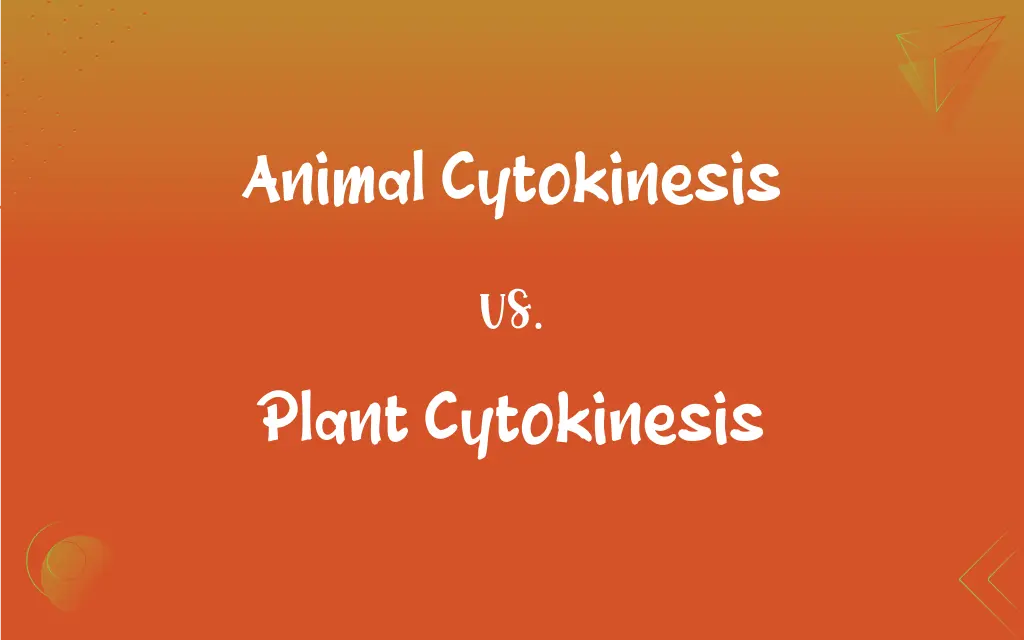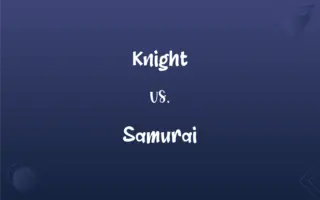Animal Cytokinesis vs. Plant Cytokinesis: What's the Difference?
Edited by Aimie Carlson || By Harlon Moss || Updated on October 29, 2023
Animal cytokinesis is the process by which the cytoplasm of a parental cell is divided into two daughter cells, while plant cytokinesis is the process of cytoplasmic division in plants, involving cell plate formation.

Key Differences
Animal cytokinesis involves the formation of a cleavage furrow that pinches the cell into two. In contrast, plant cytokinesis involves the formation of a cell plate that divides the cell into two. This difference is due to the presence of a rigid cell wall in plants, which prevents the formation of a cleavage furrow.
Animal cytokinesis is characterized by the formation of a contractile ring composed of actin and myosin, which helps in the pinching off of the cell into two daughter cells. In plant cytokinesis, vesicles from the Golgi apparatus deliver enzymes and other materials needed for the formation of the cell plate and new cell wall.
In animal cytokinesis, the process is facilitated by the interaction of microfilaments with the plasma membrane, resulting in the formation of a cleavage furrow. On the other hand, plant cytokinesis involves the fusion of vesicles at the center of the cell to form a cell plate, which then grows outwards to meet the existing cell walls.
Animal cytokinesis and plant cytokinesis are essential processes that ensure the proper distribution of genetic material and cytoplasmic contents to the daughter cells. Both processes are tightly regulated to ensure the accurate and efficient division of the parental cell into two genetically identical daughter cells.
Comparison Chart
Formation of cleavage furrow
Formation of cell plate
Mechanism of cytoplasm division
ADVERTISEMENT
Contractile ring of actin and myosin
Vesicles from Golgi apparatus
Structures involved
Interaction with plasma membrane
Fusion of vesicles
Process facilitation
Pinching off of cell
Growth of cell plate
Result of process
Absence of cell wall
Presence of rigid cell wall
Cellular structure
Animal Cytokinesis and Plant Cytokinesis Definitions
Animal Cytokinesis
Animal cytokinesis is facilitated by a contractile ring of actin and myosin.
The contractile ring is essential for the pinching off of the cell in animal cytokinesis.
ADVERTISEMENT
Plant Cytokinesis
Plant cytokinesis results in the formation of two daughter cells.
The goal of plant cytokinesis is to produce two genetically identical daughter cells.
Animal Cytokinesis
Animal cytokinesis results in the formation of two daughter cells.
The goal of animal cytokinesis is to produce two genetically identical daughter cells.
Plant Cytokinesis
Plant cytokinesis is facilitated by vesicles from the Golgi apparatus.
The vesicles deliver enzymes and other materials needed for cell plate formation in plant cytokinesis.
Animal Cytokinesis
Animal cytokinesis involves the formation of a cleavage furrow.
The cleavage furrow in animal cytokinesis ensures the cell divides properly.
Plant Cytokinesis
Plant cytokinesis is part of the cell cycle.
Plant cytokinesis is the final step in the cell cycle, following mitosis.
Animal Cytokinesis
Animal cytokinesis is part of the cell cycle.
Animal cytokinesis is the final step in the cell cycle, following mitosis.
Plant Cytokinesis
Plant cytokinesis involves the formation of a cell plate.
The cell plate in plant cytokinesis ensures the proper division of the cell.
Animal Cytokinesis
In animal cytokinesis, microfilaments interact with the plasma membrane.
The interaction of microfilaments with the plasma membrane helps facilitate animal cytokinesis.
Plant Cytokinesis
In plant cytokinesis, vesicles fuse at the center of the cell.
The fusion of vesicles is a crucial step in plant cytokinesis.
FAQs
How does animal cytokinesis differ from plant cytokinesis?
Animal cytokinesis involves a cleavage furrow, while plant cytokinesis involves a cell plate.
What structures are involved in plant cytokinesis?
Vesicles from the Golgi apparatus are involved in plant cytokinesis.
What structures are involved in animal cytokinesis?
A contractile ring of actin and myosin is involved in animal cytokinesis.
What is the result of animal cytokinesis?
The result of animal cytokinesis is the formation of two daughter cells.
Is a cell plate formed in animal cytokinesis?
No, a cell plate is not formed in animal cytokinesis.
What is the final step in the cell cycle for plant cells?
The final step in the cell cycle for plant cells is cytokinesis.
What is plant cytokinesis?
Plant cytokinesis is the process of cytoplasmic division in plant cells, involving cell plate formation.
Does plant cytokinesis involve a contractile ring of actin and myosin?
No, a contractile ring of actin and myosin is not involved in plant cytokinesis.
What happens during animal cytokinesis?
During animal cytokinesis, a cleavage furrow is formed, and the cell is pinched into two daughter cells.
What is the final step in the cell cycle for animal cells?
The final step in the cell cycle for animal cells is cytokinesis.
Are animal and plant cytokinesis essential processes?
Yes, both animal and plant cytokinesis are essential processes for the proper distribution of genetic material and cytoplasmic contents to the daughter cells.
What facilitates plant cytokinesis?
Fusion of vesicles at the center of the cell facilitates plant cytokinesis.
What is the result of plant cytokinesis?
The result of plant cytokinesis is the formation of two daughter cells.
What is animal cytokinesis?
Animal cytokinesis is the process by which the cytoplasm of a parental animal cell is divided into two daughter cells.
What facilitates animal cytokinesis?
Interaction of microfilaments with the plasma membrane facilitates animal cytokinesis.
How does the absence of a cell wall affect animal cytokinesis?
The absence of a cell wall allows for the formation of a cleavage furrow in animal cytokinesis.
What happens during plant cytokinesis?
During plant cytokinesis, a cell plate is formed, and the cell is divided into two daughter cells.
How does the cell wall affect plant cytokinesis?
The presence of a rigid cell wall prevents the formation of a cleavage furrow in plant cytokinesis.
Is a cleavage furrow formed in plant cytokinesis?
No, a cleavage furrow is not formed in plant cytokinesis due to the presence of a rigid cell wall.
Does animal cytokinesis involve vesicles from the Golgi apparatus?
No, vesicles from the Golgi apparatus are not involved in animal cytokinesis.
About Author
Written by
Harlon MossHarlon is a seasoned quality moderator and accomplished content writer for Difference Wiki. An alumnus of the prestigious University of California, he earned his degree in Computer Science. Leveraging his academic background, Harlon brings a meticulous and informed perspective to his work, ensuring content accuracy and excellence.
Edited by
Aimie CarlsonAimie Carlson, holding a master's degree in English literature, is a fervent English language enthusiast. She lends her writing talents to Difference Wiki, a prominent website that specializes in comparisons, offering readers insightful analyses that both captivate and inform.
































































